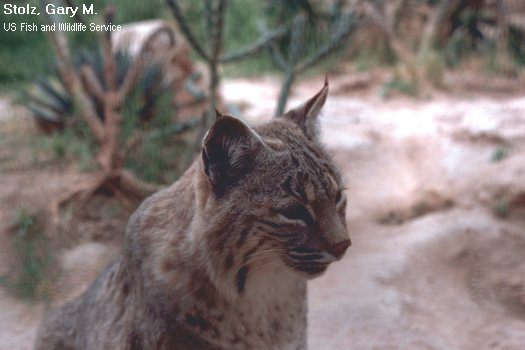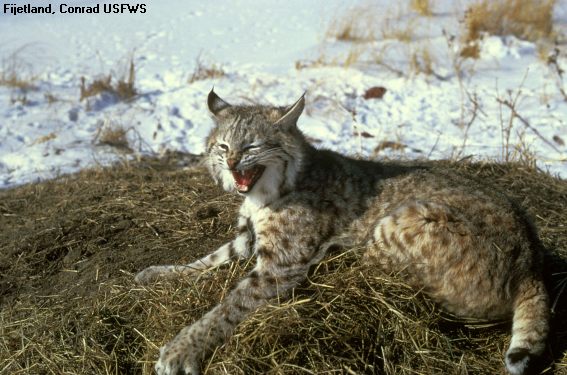
THE BOBCAT
- southern Canada, most of the US, Mexico
HABITAT (HOME)
- prefers wooded areas with thick underbrush
- den is under fallen trees, in hollow logs, bushes, caves, rock piles
- also lives in semi-desert areas, swamps, mountains
- will live near people
APPEARANCE (DESCRIPTION)
size:
- male: 80 to 100 cm long (30-40 in.) includes short tail 12 to 15 cm (5-6 in.)
- more than twice the weight of average house cat
- average weight of male: 10 kg (22 pounds) female: slightly less
colour:
- yellowish-brown to reddish-brown to greyish on its back (summer coat)
- whitish underneath
- dark spots or markings on the fur
- long outer hairs are black-tipped
other features:
- short "bobbed" tail
- large yellow eyes
- retractable claws about 4.5 cm long
- pointed ears with small tufts of black hair at the tips
- long fur hangs along cheekbones (called "facial ruff")
- (drawings)

FOOD (HUNTING)
- favorite meal is rabbit
- small prey like mice, rats, ground squirrels, chipmunks, muskrats
- larger prey like deer in winter (jumps on animal's back, bites its neck)
- will eat eggs, birds, frogs, reptiles, insects, beetles
- has powerful jaws and long pointed teeth
- sharp teeth used to tear meat into small pieces
- doesn't chew, swallows food whole
- may eat and eat till very full then not eat for days
HABITS (BEHAVIOR)
- male lives alone
- has a territory for hunting
- marks territory with scent
- likes water (house cats hate water)
- plays and swims in the water
- hunts mainly at night
- active all winter
- sounds: growl, meow, purr, hiss, snarl, howl
- excellent climber, rests in trees, climbs rocks
ADAPTATIONS
- sharp claws for hunting (catching prey), fighting and climbing
- climbs trees to rest, look for prey, escape enemies
- sharpens claws on trees
- large eyes are well adapted to seeing in the dark
- long tufts on ears help it to hear better when hunting
- waits and pounces, or stalks and pounces
- can leap up to 3 metres (10 feet)
YOUNG
- litters average three kittens (as many as six)
- kittens weigh about 200 grams, 20 cm long
- eyes are closed at birth, open in ten days
- blue eyes when born, change to yellow
- born in late April or early May
- newborns have spotted fur and sharp claws
- live on mother's milk for about two months
- at five weeks will leave den to play outside
- mother teaches them to hunt when five months old
- stay with mother till fall or following spring
ENEMIES (DANGERS)
- young are killed by coyotes, dogs, hawks, owls
- adults have few enemies except for man
- hunted for their beautiful fur
- killed by vehicles when crossing roads
MORE INTERESTING FACTS
- called lynx rufus
- close relative of the Canada lynx
( differences between the bobcat and lynx)
- numbers decreased when settlers arrived
- hated by farmers for killing farm animals
- disappeared in midwestern US (hunted, habitat destroyed, lack of prey)
- bobcats in southern region have more markings and are smaller
- largest bobcats are found in Canada
- can live 12 to 13 years in the wild
- protected by hunting and trapping laws
CANADIAN ANIMALS
photo credits :
Gary M. Stolz / US Fish and Wildlife Service
Conrad Fijetland / US Fish and Wildlife Service
Bob Savannah / US Fish and Widlife Service
photo library at http://pictures.fws.gov/
J.Giannetta
jgiannet@hotmail.com
2003, updated 2011
Web Pages for Students

